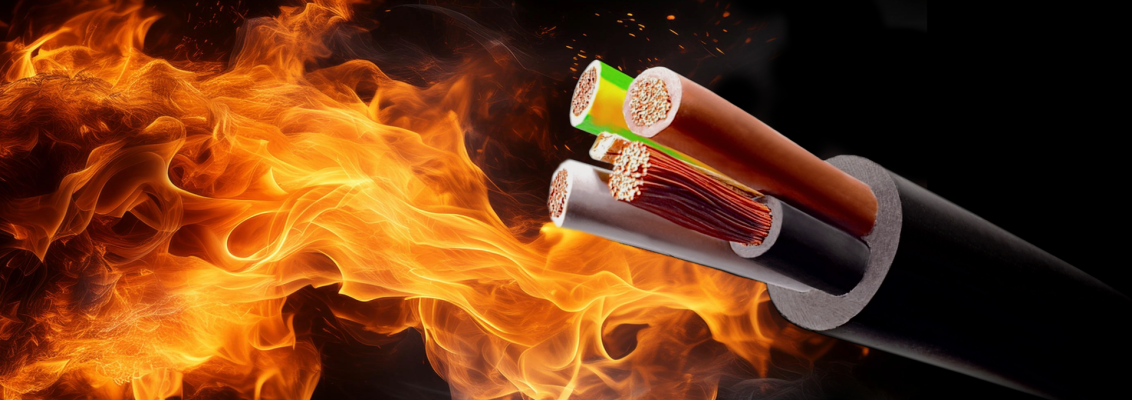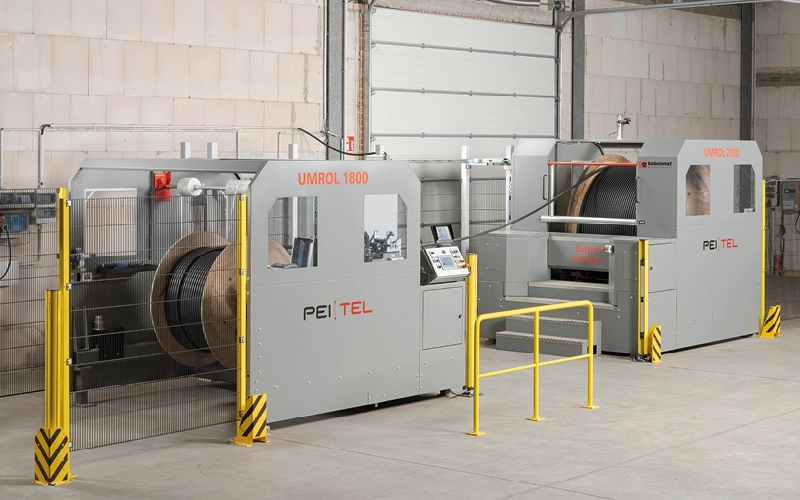FRNC, HFFR, LS0H, LSZH: What Halogen-Free Cable?
As staples across various industrial and infrastructural applications, halogen-free cables are a popular choice that have established a few different names.

Contents:
There’s a whole host of things to unpack in this article. For example, what does halogen-free mean, why is it important, why are there so many different names, and what do those names even represent? So, let’s uncoil some facts about halogen-free cables and wires.
What Does Halogen Mean?
The name “Halogen” comes from Greek roots. When we break it down, “hal” means salt and “gen” means to make. So, “Halogen” means to produce salt.
The name is given to a group of 6 elements on the periodic table. Each of these elements produces a salt when they react with metal. Even the general table salt we have at home is formed from a halogen; sodium chloride. Here are the 6 elements:
- Fluorine (F)
- Chlorine (Cl)
- Bromine (Br)
- Iodine (I)
- Astatine (At)
- Tennessine (Ts)
Where are Halogens Found?
All halogens can be found within the Earth’s crust. However, they’re not all found in the same state. Bromine is a liquid, fluorine and chlorine are gases, and iodine, astatine, and tennessine are solids.
Fluorine is the most abundant of the halogens followed closely by chlorine, bromine, and iodine. However, astatine and tennessine are thought to be some of the rarest naturally occurring elements because they’re short-lived radioactive isotopes!
Which Halogen is Most Reactive?
The most reactive of the 6 halogens is fluorine. In fact, fluorine is the most reactive element of all, because of its ability to attract electrons and chemically combine. Despite this, when it reacts with hydrogen, it produces fluoride which is used in tooth health, refrigerants, lubricants, and more.
In cables, fluorine is used as part of the material PTFE. One of the more recognisable brand names for this is Teflon. PFTE is hydrophobic, high-density, and resistant to high temperatures, making it a suitable sheath material for a wide range of applications.
When Are Halogens Used in Cable Manufacturing?
Halogens are used in the flame retardancy process. More specifically, they are used to make cable core insulation and cable sheaths. For example, chlorine is a component of PVC plastic and chloroprene rubber. Likewise, fluorine is found in high-temperature materials such as FEP, PTFE, and ETFE. We even use bromine as a flame retardant in some of our cables.
Why Halogen-Free is Required for Some Cables
Even though halogens are used as flame retardants, they still burn aggressively when ignited. While they burn, they emit noxious fumes which are harmful to people and can corrode nearby components. Not only can this be detrimental to lives, but results in time-consuming and costly decontamination efforts.
In addition, when halogens come into contact with moisture, they produce halogen halides. This leads to acid burns in the respiratory tract when inhaled.
Of course, flame retardancy is important for fire prevention, but many applications require halogen-free products. This means our halogen-free cables must be free of chlorine, bromine, fluorine, and iodine. If these halogen-free cables ignite, they produce much less acid, smoke, and overall toxicity. But it’s important to know that poisonous gases such as carbon monoxide are still emitted when halogen-free cables burn.
When Halogen-Free Cables Are Used
Halogen-free cables and wires are needed in buildings that have a high footfall or contain valuable items. For example:
Building Technology - Offices, malls, schools, hospitals, airports, and more. These places have strict fire health and safety regulations. Because of this, most cables and wires are fixed into place and don’t have special chemical or mechanical requirements. These cables use halogen-free and flame-retardant PE or PP-based plastics that produce little smoke or toxic gas. Plus, they must pass “Bundle Burning Tests” to ensure they meet standards.
Industrial Automation - Machines and plants often need cables and wires with high chemical and mechanical resistance. When used in flexible applications like robotics, these loads are especially high. Typically, we use TPE-O or TPE-U in the sheath of these cables. However, while they can be halogen-free, they aren’t manufactured as flame-retardant or low-smoke.
Typical Labels for Halogen-Free Cables
Over the years, different manufacturers, markets, regions, and standards have shaped cable naming conventions. And the same is true for halogen-free and flame-retardant cables:
- FRNC - Flame Retardant and Non-Corrosive
- HFFR - Halogen-Free and Flame Retardant
- LS0H - Low Smoke and 0 Halogen (also known as LSOH)
- LSZH - Low Smoke and Zero Halogen
Even though they seem detailed, none of these labels give all the information you need to choose the right cable. For example, it doesn’t tell you the flame retardancy, corrosiveness, toxicity, or light attenuation. So, it’s important to thoroughly read manufacturer data sheets. The information listed in these sheets is the only way to identify a cable’s flammability properties.
Because every application is unique, and yours is no exception, it’s vital to have application-matching undertaken. If you speak with one of our experts, we’ll ensure your halogen-free cable suitably meets or exceeds your requirements. Fill out our contact form here and a member of our team will be in touch.
What Halogen-Free Standards Should You Look Out For?
At HELUKABEL, we’re a German-founded company supplying the world with high-quality and high-performance cables. Because of this, we use some of the most trusted and robust standards for electrical safety.
DIN EN 60754-1 VDE 0482-754-1:2021-02 - This defines the testing machines and procedures required to identify total acidity. To be classified as halogen-free, the result from this test must be lower than 5mg/g.
DIN EN 60754-2 VDE 0482-754-2:2021-02 - This defines the measurement of the pH value and conductivity. The test result for the pH value must be below 4.3 and for conductivity, it must be under 10µS/mm.
DIN EN 61034-2 VDE 0482-1034-2:2021-02 - This defines the density of smoke and gas produced when burning cables. A light attenuation of no more than 40% is required for the cable to be considered low smoke. Depending on the application, customer, and region, lower levels may be needed. The goal is to recognise the source of the fire and identify escape routes, making it a requirement for public access infrastructure.
In many applications, where safety is critical, halogen-free cables and wires have their advantages. Less toxic gas and lower levels of smoke are emitted in the case of a fire. However, at the same time, they must be highly flame retardant. This is to ensure they comply with the varying standards and requirements across the globe.
Don’t just look at the label and make your purchase decisions from those. FRNC, HFFR, LS0H, and LSZH don’t determine flame retardancy. Always look at the data sheets for the information you need. We test our cables for various properties including flame retardancy, smoke levels, and light attenuation. Our data sheets reflect this.
If you have any questions about which halogen-free cable is best for you, rely on our 45 years as experts in electrical connection technology.
Call us on 0151 345 0808 or email the team at info@helukabel.co.uk.



_welcome_slider.jpg)